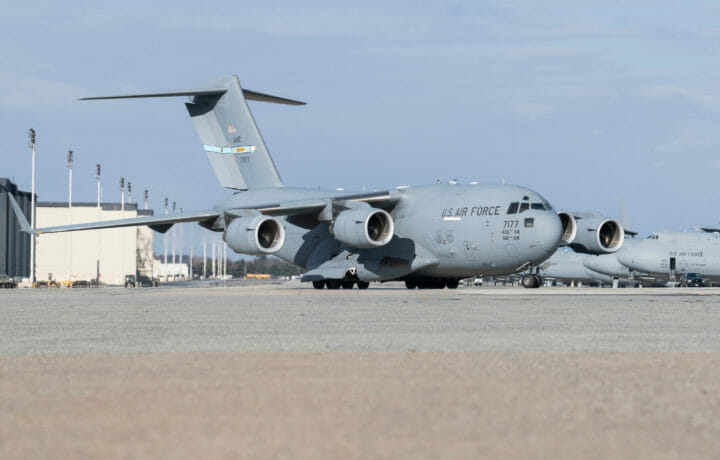Lockheed Martin Corp. is truly flying high with the United States Air Force. In addition to producing the F-35A Lightning II, the conventional takeoff and landing variant of the Joint Strike Fighter that is built for traditional air force bases, the contractor has been awarded $25 Million to transform large cargo aircraft such as the C-17 Globemaster III into so-called “bomb trucks.” Lockheed Martin expects to hold a demonstration of the capability next year.
This is part of the Palletized Munitions Experimentation Campaign, which Lockheed will use to demonstrate how the aircraft can be used to deploy a case of Joint Air-to-Surface Standoff Missile Extended Range (JASSM-ER) munitions.
“Despite the Palletized Munitions program being relatively new, it’s moving very quickly,” said Scott Callaway, Lockheed Martin Advanced Strike Systems director via a release. “The U.S. Air Force Research Laboratory (AFRL) contracting and Strategic Development Planning and Experimentation (SDPE) offices, and Lockheed Martin teams established this new contract in a record time of 30 days, supporting faster prototyping and a shorter timeline to bring this advanced capability to the warfighter in the field.”
Studies have reportedly shown that the airlifters, such as the C-17 Globemaster III, have the potential to deploy large quantities of JASSM-ER missiles, which could provide a significant increase in long-range standoff scale, and this could complement traditional strike and bomber aircrafts. This could further enable warfighters to launch offensive operations from a greater number of airfields while also engaging a larger number of near-peer adversarial targets.
Lockheed Martin reported that phase I tests successfully accomplished five high-altitude airdrops from an MC-130J and a C-17 earlier this year using simulated weapons. During this effort, the U.S. Air Force tested the suitability of launching JASSM-ERs from an airlifter.
First Two Jolly Green II Received
The United States Air Force also received the first two HH-60W Jolly Green II Combat Rescue helicopters. On November 5, the 23rd Wing and 347th Rescue Group received the newest combat rescue aircraft at Moody Air Force Base, GA. The Air Force will acquire 113 of the HH-60Ws over the next several years, and these will replace the aging HH-60G Pave Hawk fleet, which is currently used in search-and-rescue operations for the U.S. military.
The Jolly Green II feature enhanced defense systems and vulnerability reduction, as well as improved hover performance, electrical capacity, weapons, and cybersecurity. These capabilities will ensure that its crews are able to carry out their critical combat search-and-rescue missions and personnel recovery operations for all the U.S. military and its allies in contested and diverse environments. The HH-60W will be able to conduct day or night operations in hostile environments to recover isolated personnel during wartime.
Additionally, the HH-60W can be used in other military operations including civil search-and-rescue, medical evacuation disaster response, humanitarian assistance, security cooperation/aviation advisory, NASA space-flight support, and rescue command and control.
In February, Sikorsky, a Lockheed Martin Company, announced that it was awarded a second low rate initial production contract after flight tests of the rotary aircraft progressed. It was at the annual Air Force Association (AFA) Air Warfare Symposium that month that Barbara M. Barrett, Secretary of the Air Force assigned the helicopter its proper name – Jolly Green II.
“We respect the long tradition of assigning a moniker that communicates the CSAR mission. Jolly Green II is a fitting tribute to its history and to airmen and women worldwide,” said Dana Fiatarone, Sikorsky’s Vice President, Army and Air Force Systems. “The name is greatly respected by our workforce – past and present – and it’s an honor to build this critical aircraft for the Air Force and bring it to the symposium today to provide our customer with the opportunity to view the Jolly Green II in person. We look forward to continued production and executing on the recent Lot 2 contract award.”
Contract Awarded to SimpleSense
Earlier this year, the Air Force awarded SimpleSense a $1 million contract through the Small Business Innovation Research (SBIR) program run by AFWERX, the Air Force innovation team, who encourage and facilitate connections across industry, academia, and the military to create transformative opportunities and foster a culture of innovation.
The company is now collaborating with the Fire Department at Wright-Patterson Air Force Base to decrease response times by interconnecting the base’s incident response software platforms. Whereas a call that comes into the emergency communications dispatcher is manually entered into upwards of 10 different software systems, this project could reduce data entry to just a single system. That could save dispatchers significant time per incident.
“First responders rely on the decades old technology of radio and telephone as their primary means of communication,” said Fire Chief Jacob King, who heads the Wright-Patterson Fire Department. “Especially when you have multiple departments and agencies responding to a major event, these antiquated methods quickly become overwhelmed.”
Not-for-profit engineering innovation company Draper has partnered with SimpleSense to improve the emergency communication at Wright-Patterson AFB by studying the cognitive workload of the system operators as they conducted various tasks.
“No single company can solve a problem of this scale on their own,” says Eric Kanagy, CEO of SimpleSense. “We’re building a network of agile technology companies, aligned around a core mission and are excited to work with these key partners to prove solutions for the critical emergency response industry.”
SimpleSense is now partnering with Raytheon BBN Technologies to produce the Android Team Awareness Kit; System Atlanta, which is producing the Information Display System (IDS5); Centauri for the COP for Event Response Situational Awareness (COPERS); and Active911, which connects smartphones with CAD to get real-time alerts with mapping, routing, and response so that Command knows who is coming, who is available, who is there, and what resources are on the ground before anyone leaves the station.




